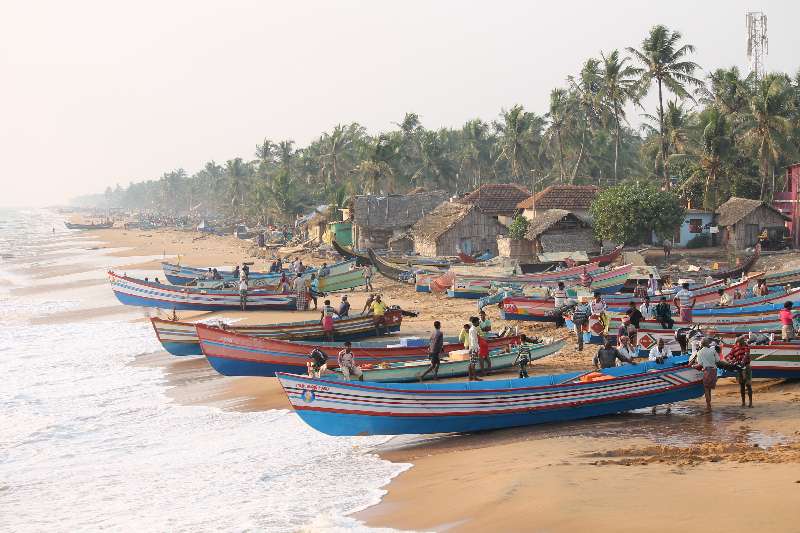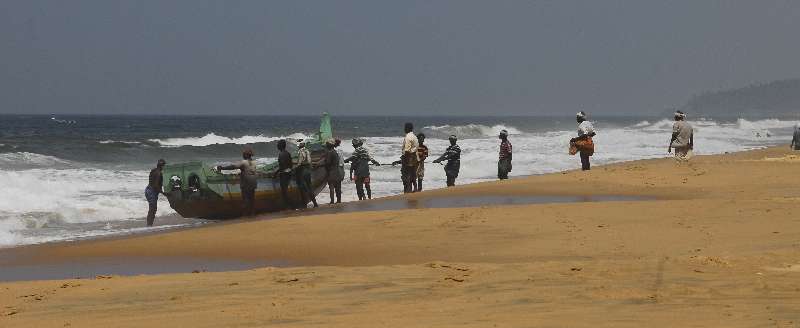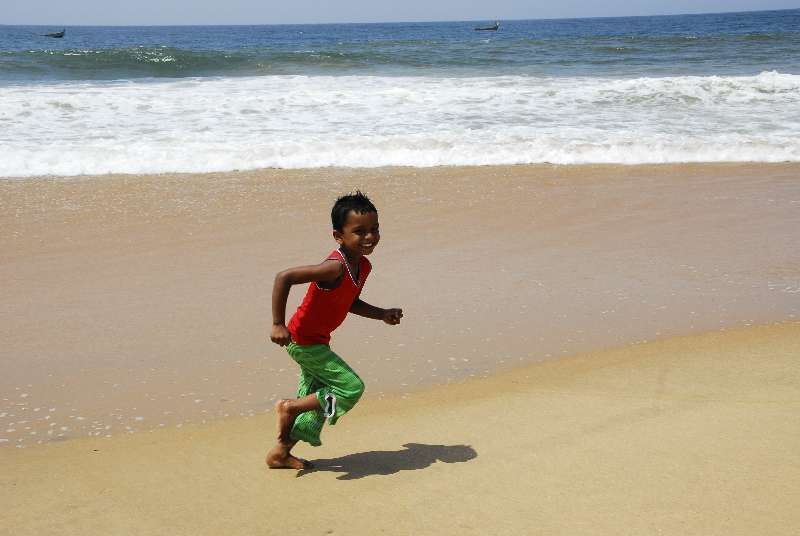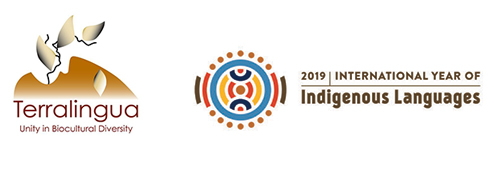by Lisba Yesudas & Johnson Jament (Mukkuvar, India)

Coastal community’s rendezvous with their destiny. Fishermen at Valiathura beach are getting ready for their daily fish catch, while other community members enjoy the evening beauty of the beach. Photo: Robert Panippilla, 2013
Marine biodiversity and cultural diversity are deeply interwoven in the coastal fishing communities of Trivandrum, Kerala, South India. This is the story of our ancestors, the story of our fellow community members; it is the story of our life! It is about our connection with the sea, the coast, and the marine environment.
We would like to tell you here how our forefathers have been safeguarding that environment and its bountiful resources. We would also like to talk about how our brothers and sisters, elders, and today’s “educated” people are feeling compelled to follow the path of “modern developers” who have little concern for the biodiversity, the rich cultural heritage, and the environment that has sustained us through the centuries. And we would like to emphasize the rapid industrialization that leads to the destruction of social identity, culture, and marine wealth, and even of the livelihood of the people who inhabit these communities. We wonder why some of our highly educated community members are reluctant to speak the coastal language, take little or no pride in their cultural heritage and ancestry, or why they are not acknowledging, supporting, and disseminating the coastal communities’ efforts to conserve the marine biodiversity of the area.

Left: A variety of fish ready for cooking. An abundance of fresh fish is part of the Trivandrum fishermen’s daily diet. Photo: Johnson Jament, 2014. Right: A day of happiness for fishermen. Fishermen at Valiathura have big smiles on their faces when they are able to amass their environmentally friendly fishing wealth. Photo: Robert Panippilla, 2013
There is little awareness about the biocultural diversity of the coast. In particular, politicians, academics, policy makers, and conservationists in India have shown minimal interest in the biodiversity of the sea and the cultural practices of the coastal communities. The coastal people are one of the most excluded, marginalized, and discriminated communities in India’s most socially developed and literate state of Kerala. Our mother tongue — our coastal language, Kadappuram Bhasha — is not considered to be worthy of recognition. Traditional fishermen’s economic contributions are not valued or promoted. Existing systems have provided limited initiatives to protect marine diversity despite the existence of a marine biodiversity register, which coastal people influence and participate in. In the official documentation and recordings of traditional knowledge, folklore, music, and songs, the coastal communities’ representation is minimal. In school textbooks, the coastal communities don’t even exist; there isn’t a single story or text about fishermen’s lives and culture. When there are discussions about environmental issues, the rich marine environment and ecosystems are often excluded.
Our mother tongue — our coastal language, Kadappuram Bhasha — is not considered to be worthy of recognition. Traditional fishermen’s economic contributions are not valued or promoted
In this context, it is important to stress the interconnection of the coastal communities with the marine environment and its ecosystems. Fishing in the deep sea is the main occupation of the people of this region. The fishermen use a range of nets, hooks, and other fishing techniques to catch a variety of fish species along with other aquatic animals. For surface-level fishing, netting is the principal method applied, whereas a line-fishing technique is used to catch the fish that dwell on the ocean bed. All these fishing techniques are based upon knowledge of the fish and their behavior, with an appreciation of their life span, migration, foraging, and habitat. These traditional methods do not involve destructive fishing practices such as bottom trawling over vulnerable habitats. A sustainability principle used by these traditional harvesters of the sea is “do not kill fish eggs and marine ecosystems.” Keeping to this principle, they do not own trawling boats. The purpose of their existence is not making a profit, but rather maintaining a sustainable living and enjoying the beauty of freshness.

An environment-friendly cooking style. A young lady, Judith Antony, is barbecuing fish (meen pollikkal) using locally available coconut tree resources. Photo: Johnson Jament, 2014
The wealth and health of the coastal communities is dependent upon their daily fish catch. That is their main source of income and sole economic activity; women are mostly engaged in direct fish selling and are responsible for making fish accessible for domestic use, hotels, and tourists. The community feels a sense of pride and satisfaction when they are able to catch adequate quantities of fish, and people become despondent and sad when their daily catch does not meet their needs. In their daily conversations they discuss the variety of fishes and different ways of catching them, and engage in debates about what type of fishing technique is appropriate for particular species in a given period of time. Fishing is not only their occupational activity, but also a cultural activity.
Eating habits and the menu of the coastal communities change daily, depending on what is caught by the fishermen. They eat more food, and with greater variety, when supplies are plentiful, and eat less when the fishing is poor. Fisherwomen are traditionally in charge of the daily recipes and cuisines. Nutrition is generally good because of cooking and eating fresh fish and a variety of species. The health and life expectancy of the fishing community fluctuates due to their eating habits and fishing-related activities. The diet is full of delicious food with fish for two or three meals a day, mixed with locally produced tapioca and red rice imported from other parts of Kerala. Coastal communities organize marriages and commemorate their important days consistently with the availability of fish catches. These are people whose lifestyles are highly influenced by their engagement with marine biodiversity.
People also have a high regard for religious ceremony, and before they begin their fishing activities, they pray, “Give us today our daily bread.” Depending on what situations they encounter on the sea, they say, “Kenkadeviamma (local pronunciation of Gangadevi amma) kappathunke,” meaning “Mother Goddess of Ganga, please protect us.” The last day of the week is observed as Sabbath (which is Sunday in their context), a day of rest in which they abstain from going out to fish. They become stronger or weaker in their belief system depending on their daily fish catch and direct experiences at sea. That is, their beliefs are strengthened when their catch is good and sea going is easy, and weakened when the catch isn’t good and they encounter trouble at sea. They may be seen lighting candles as thanksgiving and participating in religious activities and festivals when the fishing is abundant. When they have difficult experiences at sea and the catch is not adequate, they express their anger and grief, and blame their god for not responding to their needs and wants, the same way as they do when they have quarrels with their neighbours and other community members.

Seeking Kadalamma (Mother Sea)’s blessing. A group of fishermen at Karumkulam beach getting ready to cross the sea for fishing. Photo: Johnson Jament, 2014
In the language of the coastal community, the sea is called kadal, and affectionately kadalamma (Mother Sea/Ocean). Hundreds of names of marine species, ecosystems, and habitats are found in the local language. With these names, it is possible to identify diversity between species and diversity within species. It is possible to document the extinction of species through recordings of the coastal language. Vattakkanni, elappaatti, naviya kathi are examples of endangered fish species. When a word for a given species disappears from the language, this suggests that the species itself has disappeared. The word paru is used for marine ecosystems and habitats. There are hundreds of such parus along the Trivandrum coast. The word cheru refers to a muddy area underwater. According to the fishermen’s traditional knowledge, this is a type of fish habitat. And so on. The language embraces the richness of marine biodiversity.
By engaging in sustainable and environment-friendly fishing activities, coastal communities play a major role in the conservation of the marine environment of the Trivandrum coast. People hesitate allowing the use of nets that cause the destruction of fish eggs, fish hatchlings and other animals, and the local ecosystems. It is their unwritten law. They are against the extinction of fish and plant species and ecological destruction. Whenever dangerous activities come to light, they protest and discourage their fellow fishermen. It is their cultural value system.

Preparing the nets for their daily “bread.” A group of fishermen at Karumkulam beach are gearing up for the day’s fishing venture. Photo: Johnson Jament, 2014
In this way, biocultural diversity is their lives, traditions, histories, upbringing, and existence — ultimately, their very freedom. Their evolution as a community is linked to their cultural diversity, which is intrinsic to marine resources and their conservation and protection. The economic contributions and daily life interactions of coastal communities are dependent upon marine biodiversity, as are their socio-cultural resources, including their language, culture and history. Any change, displacement, or destruction of these would lead to the further exclusion, discrimination, and marginalisation of these communities.
In recent years, especially since the liberalization of the Indian economy in the 1990s, lots of changes have been happening in terms of marine biodiversity and the cultural diversity of the coastal communities. First, in place of different kinds of nets for catching various types of fish, a small group of fishermen has started taking advantage of valiya vala “big nets,” which are able to catch all kinds of fishes, including those that have not yet reached maturity. The operation of mechanized boats in the place of tholava (traditional boats made of locally available bamboo) has increased. Adakkam kolli vala, literally meaning “net killing all,” has made its appearance. Fishfinder technology has been adopted in place of people’s own insights, kaniyam (kanicham).
Secondly, some community members have become negative to their coastal language, and show a reluctance to speak their mother tongue. More and more people are shifting to the dominant languages, English and Malayalam. The medium of instruction in schools is either Malayalam or English, and these languages become a prevalent social reality. The education system discourages local people from continuing their association with the sea and the marine environment. Educated people within the communities feel proud of their children not having experience with the sea, the coast, and those play and leisure activities traditionally associated with the beach. Slowly, we are going through the “extinction of experience” of the natural environment.
Thirdly, coastal development has drastically changed the coastline. The shoreline north of Trivandrum has changed so much that there is now less and less beach, while the south end has gained more and more. Ecosystems change, and marine health becomes vulnerable. The State Government of Kerala dreams of developing a Vizhinjam Trans-shipment Container Port project that proposes to dredge 5 km of the sea, build artificial sea berths, and displace the coastal communities. The Central Government of India works with the Meenakumari Commission Report, which recommends that large foreign fishing ships be allowed in to exploit the fishermen’s traditional fishing area.

A lone boy at the beach. Jerry, the boy, is one of a decreasing number of children who use the beach for their daily physical activities and play. Photo: Johnson Jament, 2014
The biocultural diversity of the coastal communities, their changing attitude toward it, and their own efforts to continue their interconnection with the sea and marine environment all have educational implications. Firstly, biocultural diversity should be one of the basic features of the education system in India. It could be part of the primary school environmental curriculum that is already in place. The present curriculum should adapt to meet the needs of the communities and promote useful life lessons. There should be provisions to exemplify the coastal communities’ oral traditions, histories, music, games, health practices, and many other aspects of their cultural diversity. By including the fishermen’s traditional marine knowledge, it would be possible to make the curriculum relevant to the communities’ socio-economic and environmental contexts. The existing constructivist model of teaching and learning should be focused on discussing fishermen’s contributions in the area of biocultural diversity and why fishing is no longer considered a respectable or desirable occupation. Instilling marine knowledge and promoting opportunities for developing the communities’ cultural practices should be a priority for the education of these communities.
Secondly, educational reforms should acknowledge and appreciate coastal communities’ efforts to conserve and protect marine resources through their environmentally friendly and sustainable fishing activities and their close association with the sea and its ecosystems. It is important to build upon already established sustainable practices in these areas. These practices must be widely recognized, encouraged, and disseminated. Rewards and promotions should be part of this process. Higher education institutions in India and specifically in Kerala should encourage more research studies in the field of marine biodiversity and cultural diversity of the coastal communities and facilitate documentation of their traditional cultural knowledge of the sea, water, climate, fish species and other animals, and marine ecosystems.
By engaging in sustainable and environment-friendly fishing activities, coastal communities play a major role in the conservation of the marine environment.
Thirdly, any formal education systems should strive to keep the trust of the local communities and work collaboratively with them to make the idea of biocultural diversity a reality. This would create an opportunity for educators and other stakeholders in the education sector to work with traditional and indigenous communities. Communities feel positive about continuing their conservation efforts, keeping their language and other cultural resources, and transmitting these to future generations, and this attitude needs to be reinforced and supported. This would also encourage alternative development models such as sustainable economies and indigenous solutions for world problems. In the case of India, it would bring more national integration and promote respect and inclusion of the neglected sectors of society.
This story first appeared in Langscape Magazine 4(1), Summer 2015, pp. 39−43.
.
Back to Vol. 8 | Read the Table of Contents | Back to IYSC | Like Our Stories? Please Donate!
Lisba Yesudas is a member of the Trivandrum Mukkuvar community in Kerala, India. She is an Assistant Professor at St. Xavier’s College, Thumba and a PhD student at the University of Kerala’s Department of Oriental Studies, with a focus on the Indigenous coastal language. She has published books and journal articles in the regional language of Kerala.
Johnson Jament also hails from the Trivandrum Mukkuvar community. He holds a PhD and is a lecturer at the University of Northampton’s MA Education program in Bangalore, India. As well, he is an Advisor and Mentor of Coastal Students Cultural Forum, which aims to improve educational opportunities and protect biocultural diversity in coastal communities.
The Indigenous Youth Storytellers Circle: Share Your Story with the World!
 An Invitation to Young Indigenous People
An Invitation to Young Indigenous People
The Indigenous Youth Storytellers Circle is a year-long project (2019) linked to Terralingua’s flagship publication, Langscape Magazine. We aim to collect and publish personal stories from young Indigenous people who are involved with one or more of the following four Focus Areas:
- reaffirming cultural identity;
- breathing new life into their ancestral languages;
- reconnecting with traditional knowledge and practices, values, and ways of life; and
- reclaiming ancestral links with the land.
The Indigenous Youth Storytellers Circle is recognized as an official project of the United Nations’ International Year of Indigenous Languages, so your story has the potential to reach a global audience. Read more stories from Indigenous Youth.
If you are a young Indigenous person who would like to tell about your experiences connecting to your ancestral languages, cultures, and lands, we want to hear from you!





